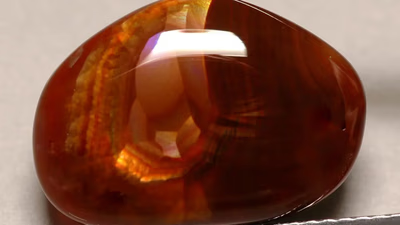
Agate formations showcase unique patterns and colors.
Agates typically form in cavities or voids within volcanic rocks or other host rocks. These cavities can be the result of gas bubbles, vesicles, or cracks formed during the cooling and solidification of lava or other geological processes. Over time, groundwater rich in dissolved silica (silicon dioxide) seeps into these cavities. The source of silica can be volcanic ash, mineral-rich water, or other geological sources. The silica-rich fluids slowly fill the voids, depositing layers of microscopic quartz crystals.
As the silica-rich fluids come into contact with the cavity walls, they begin to cool and the dissolved silica starts to precipitate. The silica molecules arrange themselves in an ordered pattern and slowly grow as tiny crystals, forming a layer on the inner surface of the cavity. This process occurs over an extended period, with layer upon layer of silica being deposited. During the formation of agate, mineral impurities present in the silica-rich fluids can influence the color and pattern of the stone. These impurities may include iron oxides, manganese oxides, chromium, and other trace elements. The variations in mineral impurities contribute to the distinctive bands and patterns seen in agates.
After the agate is fully formed, it may undergo additional geological processes, such as erosion, weathering, and exposure to groundwater. These processes can alter the appearance of agates, leading to the development of features like hollow centers, fractures, or the infiltration of other minerals, resulting in agate geodes or fortification agates.
In general, agate can be sourced from silica minerals or hydrothermal fluids, or in other cases from amorphous silica gel or hydrothermal fluids (hydrothermal fluids) or atmospheric waters. Agate is found in various geological environments in gas cavities, in acidic volcanic rocks, and fossil rock fractures. Most believe that the formation of agate coincides with the formation of its source, but some believe that the formation of agate is its source millions of years after the formation of stone.
Large amounts of agate deposits are formed from the effect of post-volcanic hydrothermal solutions on basalts and andesite. These types of reserves are found in young volcanic areas (Mesozoic – Cenozoic) of folded belts and to a lesser extent in old platforms, and economic reserves along with andesite - porphyries, andesite - basalt porous porphyries and their tuffs. Erosion of these types of reserves results in agate-rich placers. Agate volcanic hydrothermal deposits are sometimes formed in acidic volcanic rocks. These types of reserves are oval and have an uneven surface. This type of cross agate reserves 15 - 1 cm and sometimes 30 cm, and in exceptional cases to 1.2 to 0.9 meters looks. Stone cover silicified rhyolite was approximately 25-50%of the rock mass will form. The cavities in the cover stone are partially or filled with agate.
The deposition of layers continues, resulting in the characteristic banding patterns of agate. These bands can vary in thickness, color, and transparency, creating the unique and intricate patterns that are highly prized in agate stones. The banding is a result of changing conditions during the formation process, such as variations in temperature, pressure, and mineral content. Over time, the layers of silica crystals gradually solidify and harden. The process of solidification can take thousands or even millions of years, as the layers build up and the silica transforms into a compact, microcrystalline form of quartz known as chalcedony.
-

Agates form in cavities within volcanic or host rocks, originating from gas bubbles or cracks during lava cooling. Groundwater rich in silica seeps into these voids, depositing layers of microscopic quartz crystals over time. The silica can come from volcanic ash or mineral-rich water. As the fluids cool, silica precipitates and crystallizes, influenced by mineral impurities that create distinctive colors and patterns. Geological processes like erosion and weathering can further alter agates, leading to features such as hollow centers or fractures. Agate deposits often arise from post-volcanic hydrothermal solutions affecting basalts and andesites, primarily found in young volcanic areas. Erosion of these reserves results in agate-rich placers. The unique banding patterns of agate are a result of varying conditions during formation, including temperature and mineral content changes. This intricate process can take thousands to millions of years, ultimately resulting in a compact form of quartz known as chalcedony.
-

The Agate Reserves in Iran, particularly in regions like Qom, Khor, and Ferdows, showcase significant geological formations rich in agate deposits. The Qom Agate Reserve is notable for its 27. 395 million tons of andesitic ore, primarily composed of chalcedony and jasper. Khor Agate Reserve features geodes with iron oxide-rich red agate, while Chah Kasegoo offers a variety of agate nodules formed through hydrothermal processes. Each reserve presents unique geological characteristics, including volcanic rock formations and varying mineral compositions. The reserves are not only important for local economies but also serve as a vital resource for the B2B marketplace in Asia, facilitating trade in commodities like agate. Understanding these reserves can provide insights into supply chain solutions within the Middle East trade platform, enhancing business networking opportunities among verified exporters and importers. The diverse colors and types of agates found across these regions highlight the potential for regional product listings that cater to both local and international markets.
-

Agate has been a valued gemstone in the Middle East for millennia, prized by ancient civilizations for its beauty and believed protective properties. Today, countries like Iran, Yemen, Oman, and Saudi Arabia are key players in the agate trade, with rich deposits and skilled artisans who create intricate jewelry and decorative items. Yemen is particularly noted for its Yemeni Aqeeq, a highly sought-after variety used in culturally significant rings. Despite the potential profitability of the gemstone trade, Iran"s industry remains underdeveloped due to a lack of organized scientific study and modern techniques. The country has numerous agate deposits but struggles to capitalize on them effectively. Training workshops have been established to enhance skills in cutting and carving gemstones, aiming to meet international standards. The bustling souks across the region serve as vital marketplaces for agate products, attracting both local buyers and international traders. As the agate trade continues to thrive in West Asia, it presents opportunities for growth within the B2B marketplace and supply chain solutions. "
-

Agate stones are renowned for their captivating patterns and colors, formed through the crystallization of silica-rich fluids in volcanic rocks. This unique mineral composition results in a variety of types, including Blue Lace Agate and Botswana Agate, each with distinct characteristics. Agate is widely used in jewelry due to its durability and aesthetic appeal, making it a popular choice for beads, pendants, and rings. Beyond its beauty, agate is believed to possess metaphysical properties that promote balance and emotional stability. Historically significant, agate has been utilized since ancient civilizations for jewelry and decorative objects. Its accessibility and affordability make it appealing to a broad audience. Regions like Brazil, India, and Madagascar are notable sources of agate, contributing to its diverse market presence. The craftsmanship involved in shaping agate into various forms highlights the artistry of lapidary work.
Additionally, agate"s calming properties make it popular in spiritual practices such as meditation and feng shui. Collectors often seek exceptional specimens at exhibitions worldwide, further emphasizing the stone"s cultural significance.




